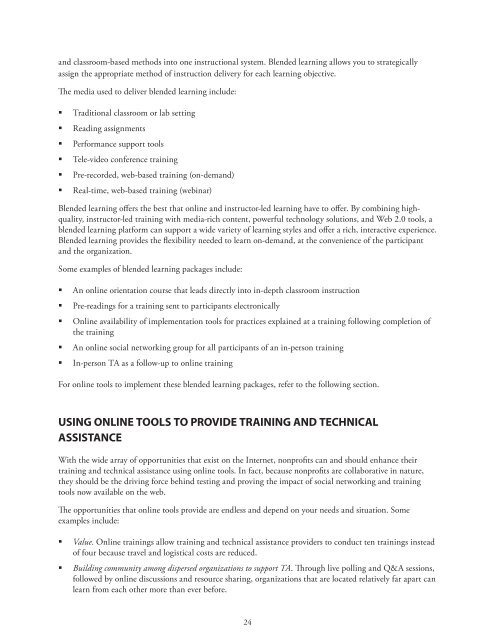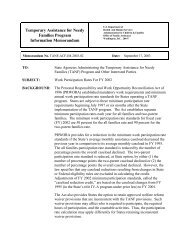Delivering Training and Technical Assistance - Administration for ...
Delivering Training and Technical Assistance - Administration for ...
Delivering Training and Technical Assistance - Administration for ...
You also want an ePaper? Increase the reach of your titles
YUMPU automatically turns print PDFs into web optimized ePapers that Google loves.
<strong>and</strong> classroom-based methods into one instructional system. Blended learning allows you to strategicallyassign the appropriate method of instruction delivery <strong>for</strong> each learning objective.The media used to deliver blended learning include:• Traditional classroom or lab setting• Reading assignments• Per<strong>for</strong>mance support tools• Tele-video conference training• Pre-recorded, web-based training (on-dem<strong>and</strong>)• Real-time, web-based training (webinar)Blended learning offers the best that online <strong>and</strong> instructor-led learning have to offer. By combining highquality,instructor-led training with media-rich content, powerful technology solutions, <strong>and</strong> Web 2.0 tools, ablended learning plat<strong>for</strong>m can support a wide variety of learning styles <strong>and</strong> offer a rich, interactive experience.Blended learning provides the flexibility needed to learn on-dem<strong>and</strong>, at the convenience of the participant<strong>and</strong> the organization.Some examples of blended learning packages include:• An online orientation course that leads directly into in-depth classroom instruction• Pre-readings <strong>for</strong> a training sent to participants electronically• Online availability of implementation tools <strong>for</strong> practices explained at a training following completion ofthe training• An online social networking group <strong>for</strong> all participants of an in-person training• In-person TA as a follow-up to online trainingFor online tools to implement these blended learning packages, refer to the following section.USING ONLINE TOOLS TO PROVIDE TRAINING AND TECHNICALASSISTANCEWith the wide array of opportunities that exist on the Internet, nonprofits can <strong>and</strong> should enhance theirtraining <strong>and</strong> technical assistance using online tools. In fact, because nonprofits are collaborative in nature,they should be the driving <strong>for</strong>ce behind testing <strong>and</strong> proving the impact of social networking <strong>and</strong> trainingtools now available on the web.The opportunities that online tools provide are endless <strong>and</strong> depend on your needs <strong>and</strong> situation. Someexamples include:• Value. Online trainings allow training <strong>and</strong> technical assistance providers to conduct ten trainings insteadof four because travel <strong>and</strong> logistical costs are reduced. • Building community among dispersed organizations to support TA. Through live polling <strong>and</strong> Q&A sessions,followed by online discussions <strong>and</strong> resource sharing, organizations that are located relatively far apart canlearn from each other more than ever be<strong>for</strong>e.24
















